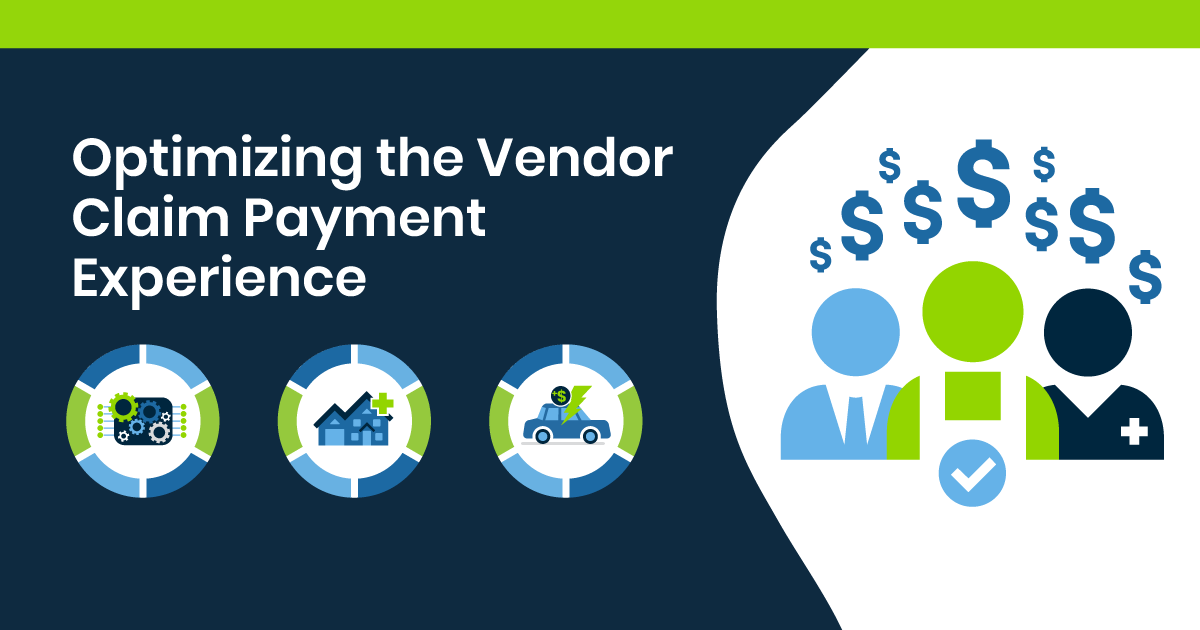
Optimizing the Vendor Claim Payment Experience
The arrival of the pandemic has greatly increased the adoption of digital engagement among all generations, serving to only strengthen demand for the ‘Amazon’ experience in all interactions. Today’s insurance customers are no longer comparing insurers to each other; their expectations are being heavily influenced by their experience in other industries. This increasing customer demand for a superior and seamless digital experience has put extreme pressure on insurers to accelerate their digital strategies and innovate with next-generation technologies.
Why Insurers Need to Prioritize Claim Payment Transformation
Insurers’ digitization goals have focused on achieving straight through processing and manifesting a touchless claims experience, but their plans have kept the most critical customer experience touchpoint – claim payment – as a manual and costly process that delivers a poor customer experience. Even though the pandemic has increased the adoption of digital payment methods among all generations, it’s estimated that 75% of property/casualty insurance claim payments are still mailed by paper check.1
Since there are not many businesses or customers that want to receive checks anymore, that can’t possibly be good for the insurance customer experience. Imagine that an adjuster settles a simple claim expediently only to have the insured wait an additional 10 days or more to access their funds. That’s certainly not the best experience for customers who are already enduring some type of hardship. Yet a recent Celent Model Insurer study revealed that almost 90% of insurers rated customer experience as extremely important for both company strategy and for generating new business.2 Clearly, there is a disconnect.
And let’s not forget that paper checks are extremely expensive and the least secure of all payment methods. According to the Association of Financial Professionals, the median transaction cost for issuing a paper check is $3 per check, which is close to 10 x more expensive than ACH.3 And checks constituted 74% of all payment fraud cases in 2019.4
But What About Vendor Claim Payments?
Property and casualty insurance claims very often result in payments to third parties. These third-party vendors — think healthcare providers, auto body shops, car rental companies, law firms, roofing businesses — can wait long periods of time to receive claim settlement checks, many times as long as 60-90 days after a service was performed. This delay in receiving funds can increase the financial instability of businesses and decrease their ability to service their customers (your policyholders).
Once they do receive a check, it may come in the form of a ‘bulk’ payment, requiring detailed remittance documentation to be attached for reconciliation purposes. Providing this detailed information and integrating it with the actual check payment can be challenging for insurers. Understanding it can be both confusing and frustrating for vendors.
In order to correctly reconcile their accounts, vendors need to be able to readily understand what payment amount correlates to which insurance carrier for which customer, as well as for what specific service and service date. And when this detail is confusing or missing entirely, the vendor has no choice but to try to track down the information by contacting the insurance carrier. As one can imagine, this reconciliation process can quickly become a tedious and time-consuming burden, taking resources away from activities that both service the customer and strengthen the business.
But although vendor claim payment, document attachment, and resultant reconciliation have long been pain points for both insurers and vendors, it doesn’t need to stay that way.
Vendor Claim Payment Optimization
Since vendor payments make up a considerable percentage of overall claim disbursements, insurers can achieve significant cost savings and gains in operational efficiency by optimizing the vendor experience through the use of digital vendor payments. And by employing diligent vendor onboarding practices that include vendor outreach and education, insurers can drive an even higher percentage of digital adoption.
Providing vendors with the ability to select their preferred payment method, including virtual card payment that enables real-time access to funds, gives these businesses much needed flexibility. Rapid reimbursement allows insurance vendors the ability to better manage their cash flow, strengthen their financial foundation, allocate resources toward growth, and provide greater service to their customers – your policyholders. And greater vendor stability only helps to strengthen the overall insurance ecosystem.
One Inc
We’re here to help. One Inc’s comprehensive claim payment platform and robust vendor network enable insurers to deliver a superior claim payment experience. Our ‘hands on’ vendor onboarding and optimization program assists carriers with vendor outreach and education, best practice implementation, data analysis and virtual card adoption. We manage 100% of the vendor claim payment experience for insurers so they can focus on the needs of their policyholders.
To discuss your claim payment and vendor needs, please call (822) 209-1688 or email inquiries@OneInc.com.
Sources:
1. https://www.insurancethoughtleadership.com/claims/3-industry-ideals-claims-payments
2. https://www.celent.com/insights/784812447
3. https://www.afponline.org/publications-data-tools/reports/survey-research-economic-data/Details/paymentscost/
4. https://www.jpmorgan.com/content/dam/jpm/commercial-banking/documents/fraud-protection/afp-fraud-survey-2020-report-highlights.pdf
Tags: Payments, Technology & Innovation

Written by The One Inc Content Team
The One Inc Content Team strives to provide valuable insights about digital trends and payments innovation for the insurance community.
Want to read more articles like this?

